The push towards electrification and modernisation of electrical grids has been amongst the forefront of government initiatives post Covid-19. By manufacturing key components that go into electric vehicles (EVs), battery management systems (BMS), smart meters and switchgears, amidst others, Shivalik Bimetal Controls (SBCL) has been quietly making its presence felt with a 130 per cent return for its investors, in the last three years.
Broadly operating under three revenue verticals – thermostatic bimetals, shunt resistors and electrical contacts – all critical components and consumables in above-mentioned sunrise sectors, SBCL’s revenue/ EBITDA/ PAT has grown at a strong CAGR of 21 per cent/ 24 per cent/ 28 per cent in the last five years. The company also has a net cash position as of H1 FY25. One of the very few vendors with the niche capability of manufacturing specialised shunts using electron beam welding (EBW) process, the company has no peers in India with similar comparable manufacturing prowess.
The temporary slowdown from the US markets is expected to pick up pace from Q4 of FY25, based on positive enquiries from its largest customer. Nevertheless, the growth in other geographies has outshone the degrowth in the US in H1 FY25, indicating resilience in demand for its products.
Trading at a TTM PE of around 41 times, the share price of the company has largely stayed flat in the last 12 months. And with the stock having corrected around 25 per cent from its peak in July 2023, investors could consider accumulating the stock on dips considering the above factors.
Business and products
SBCL, incorporated in 1984, set up the first plant in Asia to manufacture thermostatic bimetals in 1986. The company launched cathode ray tubes (CRT) in the 1990s, which found applications in CRT TVs. With the same being superseded by flat LCD, LED type TVs, this product became gradually obsolete since FY11 resulting in stagnation in revenue upto FY14. But with the launch of shunt resistors and renewed focus on thermostatic bimetals, SBCL revived its business, building capabilities in advanced and complex manufacturing technologies like EBW and diffusion bonding.
Currently, shunts and bimetals contribute to around 45 per cent each to the topline, while electrical contacts bring in the rest.
Thermostatic bimetals, used as part of overload protection devices, find application in switchgears, electrical appliances, medical devices and EVs. It helps the end-use machineries turn on or off when it gets too hot or too cold. The company manufactures around 75-plus grades in this space.
Shunt resistors help measure and sense the flow of electricity in a circuit. These find critical applications in automobiles, smart meters, power modules and BMS. Currently, SBCL operates the world’s largest capacity and production of electronic beam welding, by which the company manufactures shunts. Shunts are relatively higher margin products and enjoy a 3-5 per cent delta over bimetals, EBITDA-wise.
Electrical contacts are connecting points joined to copper wires, which are the contact points when we turn on and off switches, used across electrical appliances, smart meters, switchgears and wires, and accessories. This is lower on the margin profile when compared with the other two products.
Operating metrics
H1 FY25 saw revenue decline of 0.9 per cent year on year to ₹252.6 crore, despite a nominal volume growth of around 3 per cent. A similar trend was observed in FY24 as compared with FY23, where despite around 9 per cent volume growth, revenue growth came in at a lower 8 per cent. This trend is on the back of commodity prices – primarily, copper and nickel which account for around 50 per cent of total costs – softening from January 2023. Price of copper and nickel have corrected around 5 per cent and 48 per cent since January 2023. While copper prices have been volatile during this period, nickel has been largely on a downward slope.
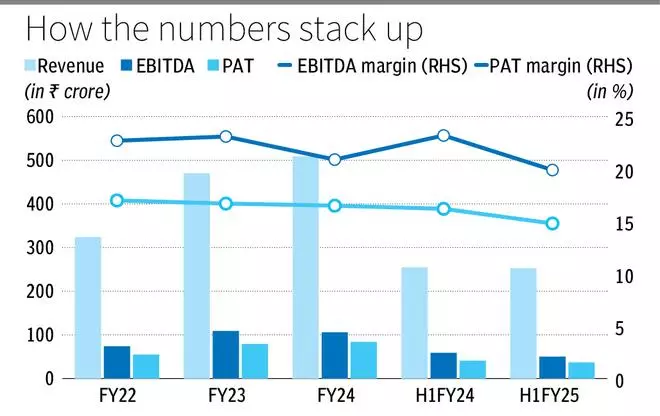
EBITDA margins too dropped year on year owing to fall in export volumes from around 60 per cent in H1 FY24 (and entire FY24) to 55 per cent in H1 FY25, an unfavourable product mix with volumes of shunt dropping as a percentage of the overall volumes, and electrical contacts coincidentally growing in volume. Recovery on this front is expected from rebound in shunts business and export volumes.
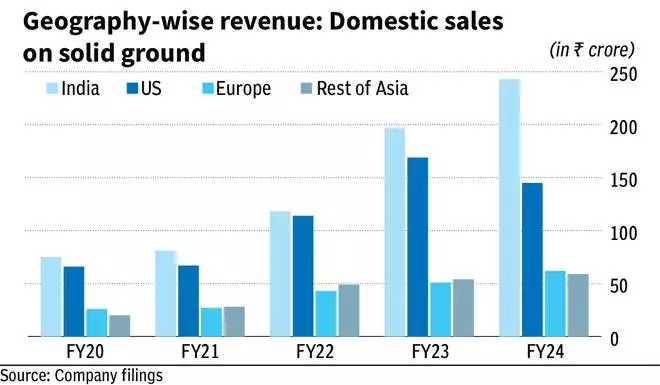
Bimetals sales to Europe and the Rest of Asia de-grew 24 per cent and 31 per cent year on year in H1 FY25, while India and the US showed a bit of resilience but still dropped 3 per cent and 5 per cent year on year respectively, resulting in a net 11 per cent decline. India continues to be the biggest market for this segment.
Shunt segment, however, saw Europe, India and the Rest of Asia grow around 40 per cent each year on year, while US de-grew 33 per cent, still reeling from inventory destocking. Despite the US traditionally being the largest market in this segment, growth in other markets helped the shunts business grow 3 per cent year on year in H1 of FY25.
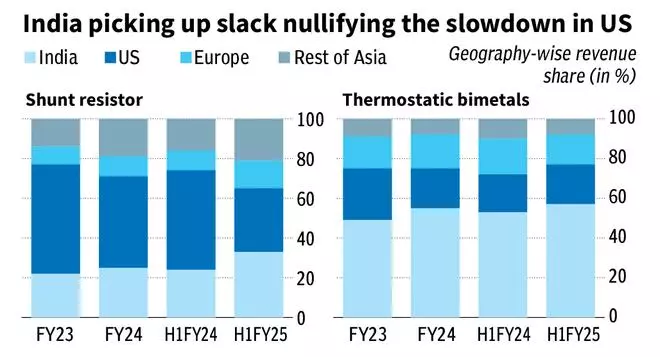
Smart meter as an end-use segment contributed to around 30 per cent of the shunt sales in H1 FY25, and automotive sector added another 60 per cent. In case of bimetals, switchgear segment contributed to around 80 per cent of the sales, while spiral coils, snap-action disks brought in the rest.
What works
The company incurred a capex of ₹75 crore over FY21-23. And with another ₹20-30 crore that will be spent over FY24-26 for brownfield expansion, the peak revenue potential, according to the management, is ₹1,600 crore, which is more than three times its FY24 revenue. Thus, no investments are required over the short-to-medium term in the ordinary course of business. SBCL also boasts of machine building capability of critical processes at a cost which is a fraction of global alternatives.
Considering the critical applications of its products, customers often have detailed and lengthy approval cycles (around three-five years). And as SBCL also works closely with its customers, and its offerings are significantly customised (around 75 per cent of its total offering), the switching costs for a customer is high and at most times, tedious. Vishay Intertechnology (tier-3 player in the automotive sector), a leading American semiconductor and electronic components manufacturer is SBCL’s largest customer. About 40 per cent of its shunt business and 30 per cent of its bimetal business came from the top 5 customers in each segment in FY23 (latest data available).
The ratio of costs of shunt resistors to cost of end-use machineries into which they are consumed such as EVs and smart meters is immaterial (around 1 per cent) and hence, customers prefer to outsource it than backward integrate. And the critical applications of these components also result in emphasis on quality than tiny cost differentials, which also bodes well for SBCL over the long term.
Demand from the automotive segment, though currently impacted by slowdown in the US markets, is expected to be strong considering EVs touted to need around 8-16 times more shunt resistors than ICE vehicles. And shunt resistors find various use-cases in BMS and EMS too, signalling bright prospects. Smart meter segment continues to grow rapidly for the company, with both shunt resistors and electrical contacts in demand with the government of India’s Smart Meter National Programme aiming to replace 250 million conventional meters by 2027. The switchgear segment, on the other hand, is expected to remain robust with sustained efforts to modernise grids and again electrification. SBCL, thus offering a proxy play to three sunrise sectors, seems to be well placed to ride the tailwinds.
Points to note
On September 27, the Sandhu family – co-promoters – exited the company. This exit has resulted in the remaining promoter (and also, the managing promoters) – the Ghumman family – raising its stake from 25.5 per cent to 33.15 per cent and the entry of institutional investors in a big way (from around 2 per cent prior, to 20 per cent now). The exiting promoter had been selling minor stakes since June 2023 and this complete exit clears the cloud around such promoter stake-selling.
The company had entered a MoU with Metalor Technologies, a leading Swiss electrical contacts manufacturer, in FY24, to explore the development of high-performance electrical contacts. But the arrangement has not worked out, and SBCL is considering alternates or to drop out from the same, quoting that significant investments might be required to work the arrangement, which seemed unattractive.
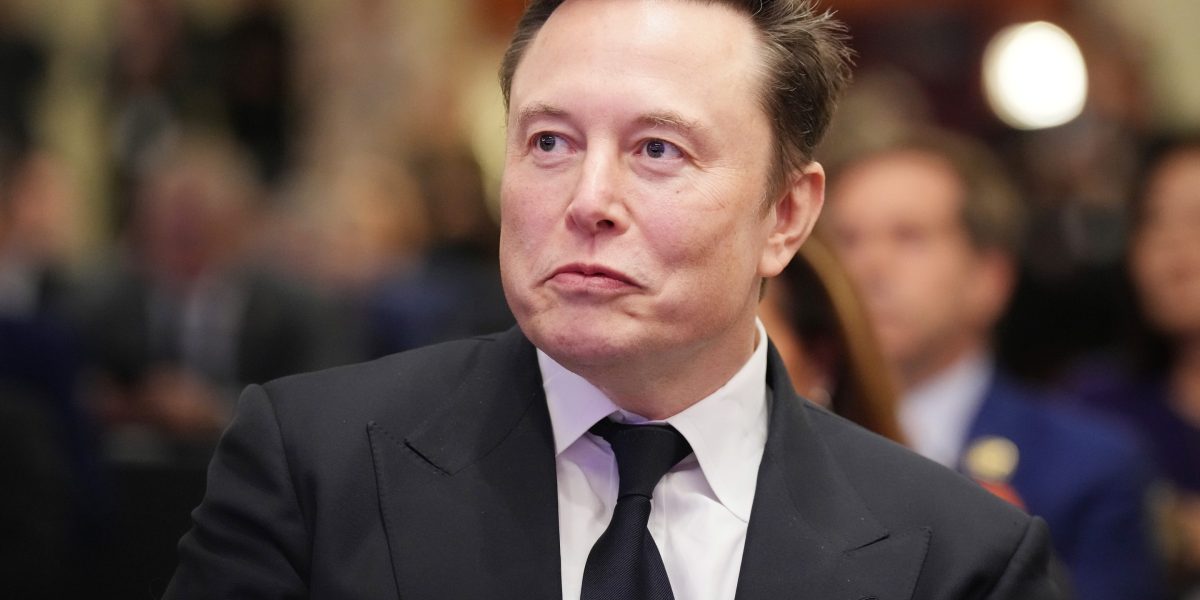
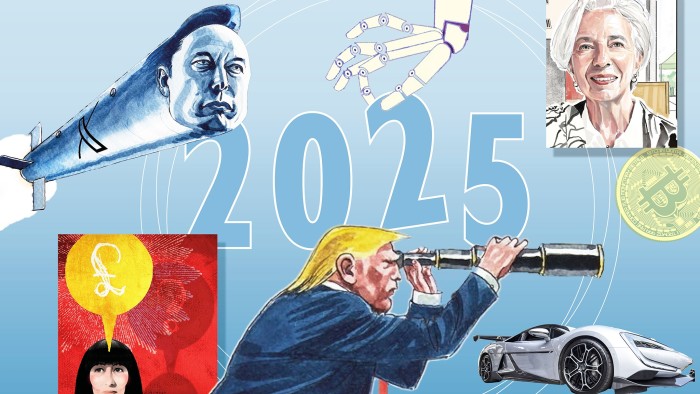


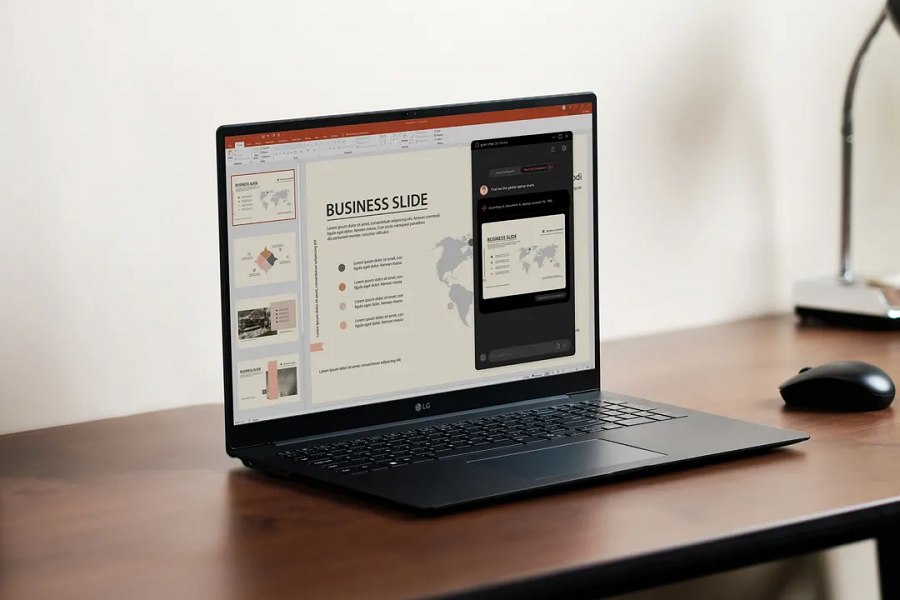
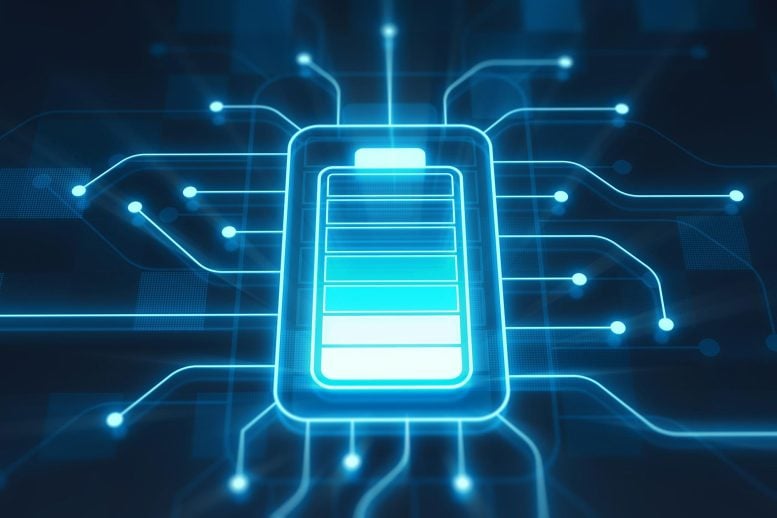

Leave a Comment